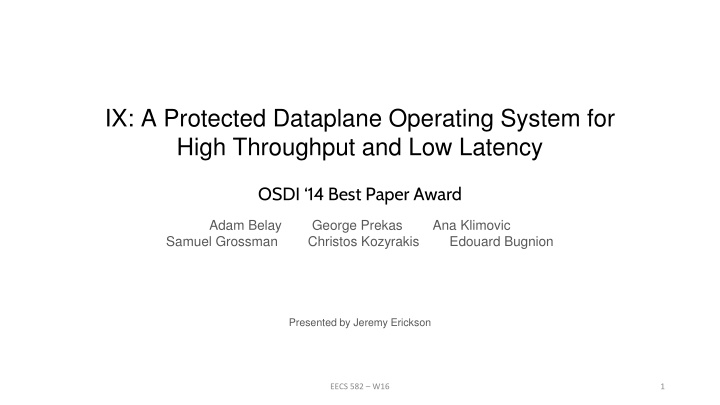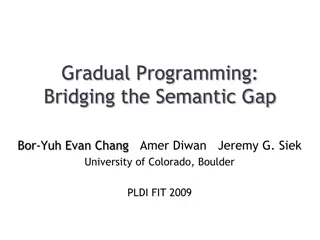
IX: A Protected Dataplane Operating System for High Throughput and Low Latency
Explore the challenges in achieving high throughput and low latency in network processing, comparing existing solutions like Linux networking stack, user-space networking stacks, and Infiniband. Learn from middleboxes to integrate the networking stack and application into the dataplane efficiently. Delve into the design aspects of the system presented in the paper for a secure and performance-oriented approach.
Download Presentation

Please find below an Image/Link to download the presentation.
The content on the website is provided AS IS for your information and personal use only. It may not be sold, licensed, or shared on other websites without obtaining consent from the author. If you encounter any issues during the download, it is possible that the publisher has removed the file from their server.
You are allowed to download the files provided on this website for personal or commercial use, subject to the condition that they are used lawfully. All files are the property of their respective owners.
The content on the website is provided AS IS for your information and personal use only. It may not be sold, licensed, or shared on other websites without obtaining consent from the author.
E N D
Presentation Transcript
IX: A Protected Dataplane Operating System for High Throughput and Low Latency OSDI 14 Best Paper Award Adam Belay George Prekas Ana Klimovic Samuel Grossman Christos Kozyrakis Edouard Bugnion Presented by Jeremy Erickson EECS 582 W16 1
What do we want? We want our networks fast! (Specifically, packet processing on commodity servers) When do we want it? Now (Or back in 2014) 2 https://memegenerator.net/instance/64946097
Challenges Tail Latency Some SLAs require s tail latency High Packet Rates Key-value stores - tons of small packets Protection Multiple services share a single server Resource Efficiency Load varies significantly over time https://memegenerator.net/instance/57260030 3
What else is out there? Basic Linux Networking Stack Potentially tuned for parallel incoming connections User-space Networking Stacks mTCP (NSDI 14 - April compared to IX s OSDI 14 in October) Not secure Infiniband (RDMA) Requires special hardware -- datacenter only Some others... 4
Why dont we just use those? Basic Linux Networking Stack Too slow User-space Networking Stacks mTCP (NSDI 14 - April compared to IX s OSDI 14 in October) Not secure Infiniband (RDMA) Requires special hardware -- datacenter only Some others... 5
Lessons learned from Middleboxes Integrate the networking stack and application into dataplane Application gets (almost) direct access to hardware Run each packet to completion No context-switching to introduce latency (tail-latency, yuck) Adaptive batching when congested for higher throughput Also prevents Head-of-Line blocking 6
Design The paper provides this diagram: I thought it was a little hard to see what s going on. 7
Design (maybe this is easier to visualize?) Similar to Exokernel, but with system protection and backwards compatibility httpd (libix) memcached (libix) Ring 3 Ring 0 (Dataplane) Ring 3 ... IX IX IXCP App1 AppN Dune Linux kernel VMX Ring 0 Hardware 40Gbps NIC 40Gbps NIC 1Gbps NIC Core 1 Core 0 Core 2 Core 3 8
Important details Zero-Copy API Packets are grabbed from NIC by IX and put in memory buffer Memory buffer is exposed to dataplane application Read-only through virtual memory protection Incoming traffic is randomly distributed among threads Uses NIC hardware Receive Side Scaling (RSS) For outgoing traffic, they probe ports to find same thread for return traffic The non-IX portion of the machine can still run legacy code! Backwards compatible! 9
Performance 10
Performance 11
Performance 12
Questions What potential performance downsides are there to this approach? What potential usability downsides are there to this approach? How could they make it even faster? They mention at the end of the paper that they could take advantage of Single-root input/output virtualization (SR-IOV) to share the NICs between multiple dataplanes and scale even harder 13
Questions What potential performance downsides are there to this approach? Large packets + Run-to-Completion + Slow Application ?= Delay What potential usability downsides are there to this approach? Applications must be specifically developed (or ported) to a new API How could they make it even faster? They mention at the end of the paper that they could take advantage of Single-root input/output virtualization (SR-IOV) to share the NICs between multiple dataplanes and scale even harder 14






















